Iran
 From Rationalwiki
From Rationalwiki _-_IRN_-_UNOCHA.svg.png)
“” The American people have the greatest respect and admiration for the Iranian people. Your Kings from Cyrus and Darius are known among those famous monarchs who have advanced the cause of humanity. Your scientists have contributed to the foundations on which we have built our industrial society. Your philosophers and poets have enriched the culture of the West.
|
| —US president Dwight Eisenhower to Shah Reza Pahlavi.[1] |
Iran (Farsi: ایران Irān e-rahn) sometimes incorrectly pronounced "I ran", officially the Islamic Republic of Iran (جمهوری اسلامی ایران Jomhuri-ye Eslāmi-ye Irān) and known as "Persia", is a large and populous country sitting at the eastern end of the Middle East. As a country run by Shias in a region dominated by Sunnis, it has traditionally had hostile relations with most neighbors. These neighbors include Turkey, the Gulf States of Saudi Arabia and Bahrain, the former Soviet Turkic republics, and the rowdy neighbors Afghanistan and Pakistan. Iranian national identity is closely tied to its status as the continuation of its ancient civilization, referred to as Persia by outsiders. One of those Persian dynasties, the Safavids, was largely responsible for Iran's mass conversion to Shia Islam. Iran's capital and largest city is Tehran.
Iran is one of the ancient cradles of civilization, being home to the Elamite kingdoms, the ancient Median culture, and the massively powerful Achaemenid Empire. The Achaemenids fell to Alexander the Great in the 4th century BCE and were divided into several Hellenistic states. An Iranian rebellion established the Parthian Empire in the 3rd century BCE, succeeded in the 3rd century CE by the Sasanian Empire, a leading world power for the next four centuries. During this early period, Zoroastrianism was the dominant religion in Iran. In the 7th century CE, the Arab followers of Muhammad's fancy new Islamic religion invaded the lands outside the Arabian Peninsula, including Iran. Islamic soldiers forcibly converted the populace to Sunni Islam, threatening them with Jizya (an Islamic tax given to non-muslims) if they resisted. Iran's rich culture permeated the Islamic world during the religion's golden age, but the end of that golden age coincided with Iran's conquest by first the Seljuk Turks and then the Mongol Empire. Not a culture that stayed down for long, the Iranians rose again. They established themselves as a state once more under the Safavid dynasty, during which many of Iran's modern characteristics came into being.
After having its heyday as a regional power, the Safavid Empire started declining rapidly due to constant wars with the Ottoman Empire and the Russian Empire. The Safavid dynasty was replaced by the Qajar dynasty, and during this period, Iran adopted a modern constitution that limited the Shah's power and established a legislature. Unfortunately, Iran came under heavy foreign influence from Western powers seeking control of its formidable oil reserves. When one of Iran's prime ministers, Mohammad Mossadegh, tried to limit that foreign control, the CIA and British intelligence launched a coup against him in 1953. That coup ended Iranian democracy and saw the Shah take over as an absolute monarch. Although Iran was a staunch Western ally, the Shah treated his people like shit, and a revolution against him was inevitable.
Said revolution manifested in 1979 under religious leadership, and it established Iran as the theocratic Islamic Republic. That new regime was then strengthened when it immediately came under attack by Saddam Hussein; the Iran-Iraq War united Iranians against a common enemy and behind their new government.
Relations with the West soured after the revolution, and the US has been waging a proxy war on Iran for about 40 years now. The US support for Israel and Saudi Arabia makes Iran angry, while Iran's sponsoring of Shia militias and Hezbollah has pissed off the West. Iran is under heavy economic sanctions and is now surrounded on all sides by countries hosting US military bases.[2] However, Iran still maintains its status as a regional power free from American influence.
About the name[edit]
In 1935 the Iranian government requested those countries which it had diplomatic relations with to call Persia by its endonym Iran, which has always been the name of the country in Persian (ایران). The suggestion for the change is said to have come from the Iranian ambassador to Germany, who came under the influence of the Nazis.[3][4] Germany was in the grip of racial fever and cultivated good relations with nations of "Aryan" blood. It is said that some German friends of the ambassador persuaded him that, as with the advent of Reza Shah, Persia had turned a new leaf in its history and had freed itself from the pernicious influences of Britain and Russia, whose interventions in Persian affairs had practically crippled the country under the Qajars, it was only fitting that the country is called by its own name, "Iran". This would signal a new beginning and bring a new era in Iranian history to the world and signify the Aryan race of its population, as "Iran" is a cognate of "Aryan". The Iranian Ministry of Foreign Affairs sent out a circular to all foreign embassies in Tehran, requesting that the country be called "Iran".[4] Diplomatic courtesy obliged, and the name "Iran" appeared in official correspondence and news items. Iranian scholar Ehsan Yarshater regarded the naming change as "a grievous error based on a misdirected sense of nationalism."[5] Nevertheless, the debate on what the country ought to be named internationally continues, with exiled Iranians largely preferring the exonym Persia to dissociate themselves from the current regime.[6]
Historical overview[edit]
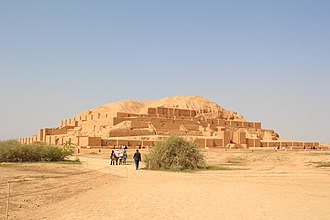
Ancient history[edit]
When we say ancient history here, we mean ancient history. Various early hominids lived in the region hundreds of thousands of years ago, and humans started growing grains here at least 12,000 years ago.[7] Iran was also the home of the world's oldest known wine jar, dating from 7,000 years ago.[8] Iran is also home to one of the oldest cities globally, Susa, established around 4200 BCE and became one of the region's most important cities for millennia afterward.[9]
By around 3000 BCE, the rest of the Iranian region followed suit and started urbanizing, giving rise to the Elamite civilization and culture.[10] The Elamites were influenced by the nearby ancient Mesopotamian civilization, and they built the only known ziggurats that weren't associated with the Mesopotamians.[11] Idiots might think that the existence of many ziggurats is somehow evidence of the inherent specialness of pyramids. That shape is just the most efficient way of piling rocks.[citation NOT needed] Mesopotamian influence on Iran became even stronger when it came under occupation by first Akkad and then Ur.[12]
Other groups also migrated into Iran from further north, so during the ancient times, there were several groups of people in the region. First were the Scythians, nomadic raiders living in the Zagros Mountains.[13] Then there were the Medes and the Persians, who settled as agrarian cultures and paid tribute to their more aggressive Mesopotamian neighbors.[13] During the 7th century BCE, the Persians were ruled by Hakamanish, known as Achaemenes to the Ancient Greeks. One of his descendants would become Cyrus the Great, the man who united the various Iranian peoples into their first great empire.
Achaemenid Empire[edit]
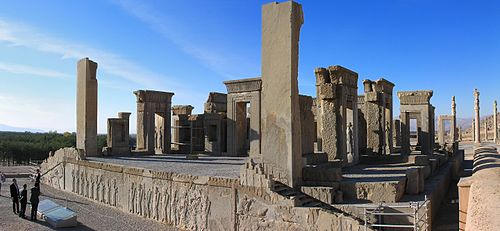
“”Cyrus’s multiculturalism made an enduring imperial peace a real possibility at last and defined the way later empires sought to achieve stable rule.
|
| —Peter Davidson, Ancient History Encyclopedia.[14] |
The Persian tribes started unifying through conquest, and they created something of a weak "empire" that would be inherited by Cyrus the Great. Around 1000 BCE, the priest Zoroaster started spreading his ideas about religion, specifically that there were only two gods. These were Ahura Mazda, the god of goodness and wisdom who should be worshiped, and Angra Mainyu, the god of evil and lies who should be appeased.[15] Zoroaster's ideas were initially met with resistance from the traditionally polytheistic Iranians. However, he finally won support from one of the regional kings, and his religion became dominant by the time of Cyrus the Great.
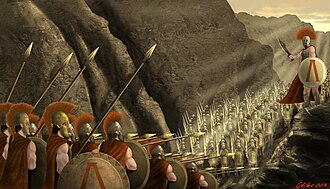
When Cyrus came to power, he completely redefined what it meant to be an empire. Cyrus took the title "Shah", or King, and he built his state on the principle of cooperation. He spared conquered rulers and sought their advice, and he allowed his people extensive religious and personal freedom.[14] Cyrus didn't take the city of Babylon by force; instead, he convinced the people that he would be a better ruler than their king and was thus welcomed into the city on a metaphorical red carpet. Most unusual of all, Cyrus was even nice to the Jews. He freed the Hebrews from captivity in Babylonia and gave them money to rebuild their old city of Jerusalem.[14] This was both kind and cynical, for Cyrus gained an unshakably loyal buffer state between himself and Ancient Egypt.
The Achaemenid Empire could have been something pretty great. However, Cyrus died, and his successor Darius I abandoned many of Cyrus' policies in favor of heavily taxing everyone to build a giant army and brutally putting down the resulting revolts.[16] Darius also gave himself a new title, the grand "Shahanshah", or "King of Kings." Darius' son, Xerxes I, was even worse. Xerxes ignored the old multicultural policies, destroyed Babylon in retaliation for a revolt, and launched the famously failed invasion of Ancient Greece.
After this humiliation, the Achaemenid Empire slid into its period of decline as people were overburdened with taxation and wasteful spending, and local authorities increasingly ignored rulings from the capital. The empire was finally put out of its misery by Alexander the Great.
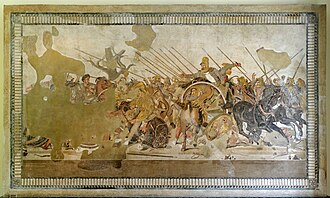
Despite this ignominious end, the empire should be best remembered for its great influence on future cultures and the modern-day. Darius revolutionized the economy by placing it on a silver and gold coinage system. The extensive Persian trade network led to the propagation of Persian words worldwide.[17] Some of these words made their way into the English language, including bazaar, shawl, sash, turquoise, tiara, orange, lemon, melon, peach, spinach, and asparagus.[17]
Seleucids and Sassanids[edit]
Alexander the Great was determined to rule and hold Iran. Alexander defeated the last Achaemenid Shahanshah at the Battle of Issus in 333 BCE,[18] and he then ordered 10,000 of his officers and soldiers to intermarry with Iranian women.[19] Alexander's plans would never be realized. He died young, and his vast empire was divided among his commanders. General Seleucus became ruler of Babylon and Persia, and he encouraged mass immigration of Greeks into the region.[19] The Seleucid Empire was originally quite similar to Cyrus' original dream. It was a harmonious blending of eastern and western cultures with an effective bureaucracy and lucrative trade network.[20] Like many empires before and after it, though, the Seleucid state eventually became too big to govern and fell apart.
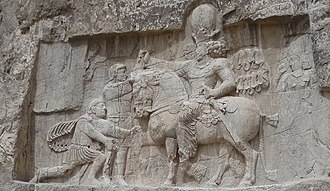
One of the groups that rebelled against the Seleucid rule was the Parthi on the coast of the Caspian Sea. They were probably descended from the old Scythians.[21] The Parthians first broke free from Seleucid rule and then conquered Persia for themselves in 247 BCE. The Parthians were pragmatists who ruled with a relatively light hand in exchange for their subjects' loyalty, and they also grew into a powerful state. They conquered the west and bumped into the Roman Empire, leading to a long series of wars between the two rival great powers. The Parthians did well for themselves at first by defeating Marc Antony. However, they lost conflicts against the Roman emperors Trajan and Lucius Verus and saw much of their land devastated by raids and warfare.[21] They also tended to quarrel over who should claim the throne after a powerful ruler died, with one such period lasting thirty years!
The Parthians fell apart to be replaced by the Sasanian Empire in 224 CE. The Sassanids were native Persians, and they resented the long period of Greek rule. They sought to obliterate the influence of Greek culture, and they repeatedly clashed with the Greek Byzantine Empire.[22] These long decades of warfare exhausted both empires, resulting in heavier taxation and more rural unrest.[22] That tends to happen in forever conflicts. This all created the perfect opportunity for an outside force to take over.
Early Islamic era[edit]
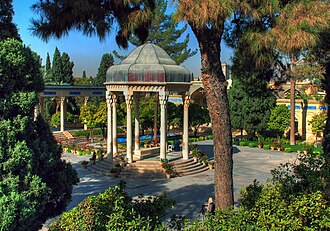
“”These events have been variously seen in Iran: by some as a blessing, the advent of the true faith, the end of the age of ignorance and heathenism; by others as a humiliating national defeat, the conquest and subjugation of the country by foreign invaders. Both perceptions are of course valid, depending on one's angle of vision.
|
| —Bernard Lewis |
After prophet Muhammad united Arabia, his successor, the first caliph Abu Bakr, decided to expand on these conquests by beginning simultaneous wars against Byzantium and Persia. By 641 CE, the Arab armies had wholly destroyed the Sassanid military, and the rest of Iran was quelled by 650.[25] Although widespread Islamaphobia and modern terrorism have shaped the Western view of the early Islamic conquests, the Muslims were actually fairly benevolent rulers. This was by necessity, as they knew they couldn't control territory as large as Iran without the cooperation of the people. Thus, the Muslims respected local religions and cultures.[25] Although conversion to Islam came with political and monetary benefits, conversion was pretty slow. Political elites converted pretty quickly, but the general peasant population didn't fully embrace the new religion until about the 9th century, about 200 years later.[25] The Muslim conquerors adopted the Sassanid coinage system and many Sassanid administrative practices, and later caliphs adopted Iranian court ceremonial practices and the trappings of the Sassanid monarchy. Iranian men served in government, and Iranian artists and intellectuals had their works distributed across the Muslim world.
However, there was still trouble brewing. The Iranians took advantage of the waning power of the caliphs to win greater autonomy. There was also a community of people in southern Iraq who maintained that leadership of Islam following the death of Muhammad rightfully belonged to Muhammad's son-in-law, Ali, and to his descendants. These people became called the Shiat Ali, meaning "the partisans of Ali", or the Shias.[25] They were initially a minority in Iran, but they would gradually grow in power.
Turkish and Mongol invasions[edit]
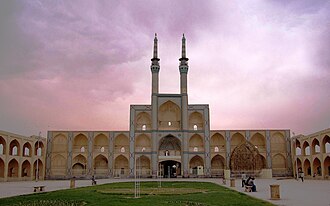
As the Abbasid Caliphate waned in power, it relied more and more heavily on slave warriors brought in from Turkish areas to the north of Iran.[25] The Turks became influential as a result, and they formed independent dynasties across Iran as the Abbasid state collapsed. These independent states didn't last too long before they were conquered by the Seljuks, who also adopted Persian culture and conquered themselves much of the Middle East.[26] The Seljuks faced a severe internal threat from the Ḥashashiyan, or the Order of Assassins, a sect of Shia Muslims who spread terror throughout the Middle East by murdering Sunni and Christian rulers.[27] They are the source of the modern English word "assassin".
The Turkish period came to an end when the Mongols rolled into town and started wrecking shit. The Mongol conquests were exceptionally brutal in Iran, and it's estimated that the wars and destruction killed about 75% of the Persian population, maybe 10 to 15 million people.[28] Genghis Khan's empire collapsed as it was divided between his heirs. His grandson Hulagu Khan became the ruler of the Ilkhanate, which encompassed Iran and its surroundings. Although being hit by depopulation and the Black Death, Mongol rule integrated Iran into a continent-spanning trade network that brought in goods from China and India.[29] The Ilkhanate eventually lapsed into many smaller dynasties before they were again conquered by the Muslim Mongol warlord Timur Lenk. The Timurid Empire controlled the region until the mid-1400s before meeting the same fate as the preceding Mongol rulers.
Safavid Empire[edit]
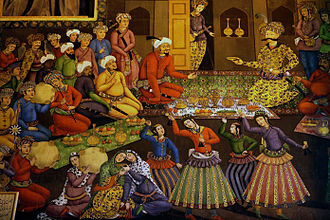
During the collapse of the Timurid Empire, a militant Shia order started to seize land for itself. The leaders of this order were the Safavids, and the head of the dynasty, Ismail, was crowned the first Shah of Persia in 1501.[30] He was the first Persian to rule Persia in hundreds of years. Upon taking control of Persia, the Safavid dynasty almost immediately declared Shia Islam the state religion and began the process of mass converting Persians.
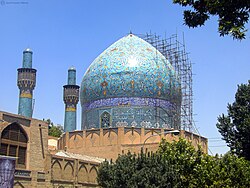
The Safavids accomplished this conversion by beginning harsh persecution of Sunni Muslims.[31][32] Methods of forced conversion included massacres, destruction of Sunni mosques, and confiscation of property.[32]
The Safavid state was nothing short of an absolute theocracy, as you can expect. The Shah claimed both temporal and spiritual authority, and he exercised control of religious affairs through the sadr, who was Iran's lead religious official.[30] This religious emphasis put the new Persian state at odds with the Turkish Ottoman Empire, and wars between them were continuous. These wars proved to be the cause of the dynasty's later downfall, as military defeats effectively disproved the lie that the Safavid rulers were in any way divine.
The Safavid dynasty reached its peak during the reign of Shah Abbas I, known as Abbas the Great. Abbas went on a mosque-building spree to show off his personal piety, but he also allowed a gradual separation of religion from state affairs.[30] His reign saw many military victories against Persia's enemies like the Ottoman Empire and the Uzbeks. Abbas also led a military campaign that ousted the Portuguese from Bahrain, but he invited other Europeans to participate in Persia's vibrant trade network.[30] He used that wealth to patronize the arts, encourage education, and build a new capital at Isfahan.
After Abbas I, the Safavid Empire started to decline. It suffered from a succession of weak rulers, high taxation, and lost wars. The Safavid rule ended with an invasion by Afghanistan and then the rise of the short-lived Afsharid dynasty.[33]
Qajar dynasty and the Constitutional Revolution[edit]
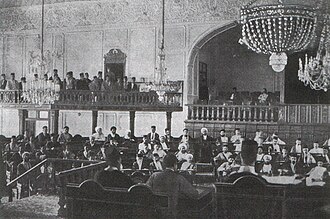
The Afsharids decided to immediately embark on many costly foreign wars that destabilized their rule and plunged Iran into a civil war between various factions.[34] War, you see, is stupid. Warlord Agha Mohammad Qajar came out on top, declared himself the new Shah, and decided to revive the old tradition of the Shah claiming holy authority.[35] That wasn't the state's biggest problem, though.
The Qajars' biggest problem was that they had come to power at just the wrong time, for they were sandwiched between two huge empires and were in the crosshairs of a third. The Ottoman Empire and the Russian Empire both aimed to conquer large tracts of Iranian land, and the British Empire wanted to shore up British India's western border.[35] Cue a series of lost wars in which Russia and the Ottomans seized control of the Caucasus while the British landed troops in Iran to control its trade and ensure the Qajars stayed away from Afghanistan.
The bureaucracy became corrupt and inefficient, and the Qajar shahs knew that something needed to change if Iran would survive into the modern era. In 1896, Mozaffar ad-Din became the new Shah, and the public was pissed off at him because he borrowed money from foreign creditors to prop up his own extravagant lifestyle.[35] He also let Westerners run roughshod all over his country and people in exchange for bribes. By 1905, a nationwide protest movement developed to curb the Shah's authority and establish the rule of law. After government troops shot a sayyid, a descendant of Muhammad, protests turned into uncontrollable riots that finally forced the Shah to agree to a constitution in 1906.[36]
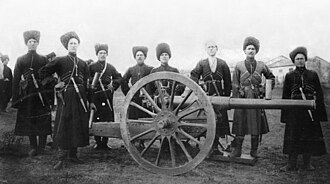
The new constitution provided, within limits, freedom of the press, speech, and association and security of life and property.[37] It also limited royal power in favor of an elected parliament and gave the Shah a parliament-appointed cabinet. Unfortunately, Muzaffar finally died right at the moment when that was a bad thing. His successor unleashed a reign of terror in his attempt to rescind the constitution, sparking a quasi-civil war that ended with his defeat and exile in 1909.[38]
Even with the old shah gone, Iran was still a stomping ground for foreign powers. That sore point got a lot worse in World War I when Iran became a battleground between the British and Russians and infiltrators from the German Empire, despite being a neutral country.[39] After the war, the German Empire was dismembered, and the Russian Empire got sucked into its own revolution, freeing the way for the British to make Iran into a protectorate in 1919.
Once in control of Iran, the British decided to do some remodeling. They encouraged a coup in 1921 that swept the Qajar dynasty out of power and swept the Pahlavi dynasty into it.[40]
Pahlavi dynasty[edit]
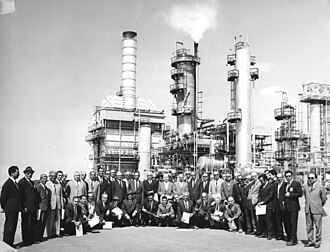
Modernization[edit]
Reza Khan became the new Shah, and he almost immediately used his now limited powers as shah to modernize Iran. He built up the military and used it to forcibly settle Iran's tribes, and he then set about establishing secular schools and universities.[41] The Shah's primary project soon became breaking the religious hierarchy's control over Iran. He ended the clerical monopoly over education, pushed through a secular code of law, created a secular judiciary, and placed state controls on the clergy. However, the Shah had ultimately overruled the parliament's authority in accomplishing this. The Shah decided that he quite liked having absolute power, so he became just another dictator by ordering his cops to beat the shit out of his political opponents and jailing people arbitrarily.[41]
He also came to resent British control over much of Iran's economy. Back in 1908, British prospectors discovered a shitload of oil under Iran. They created the Anglo-Persian Oil Company, later called the Anglo-Iranian Oil Company, controlled by the British government and didn't share much profit with the Iranians.[42] The Shah unsuccessfully tried to renegotiate the oil agreement and then opened trade with Nazi Germany out of spite. Germany was Iran's largest trading partner by World War II.[41]
Despite being neutral, Iran was occupied by the British and the Soviets during World War II. They did this to secure Iran's oil fields and ensure that Iran could be used as a secure pathway to route foreign aid to the Soviets.[43] The Allies forced Reza Khan to abdicate for being a Nazi sympathizer during the occupation. He was replaced by his son, Mohammad Reza.
The democratic years[edit]
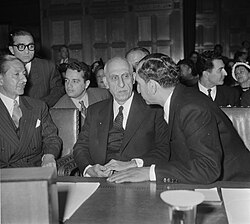
“”In a twist of irony, America, fearing communism, swung its big old freedom stick and hit the innocent young Persian democracy.
|
| —Cody, AlternateHistoryHub.[44] |
From 1949 on, sentiment for the nationalization of Iran's oil industry grew. Iranians knew quite well that the profits from the Anglo-Iranian Oil Company were not being distributed equally between the two powers, and they wondered why the British should get almost all of the pie when the oil was under Iranian soil and being drilled by Iranian workers. The 1949 parliamentary elections were centered around oil, and Mohammad Mossadegh became prime minister on the promise to nationalize Iran's oil.[45]
Negotiations with the British fell through, so the Iranian parliament voted to nationalize the oil in 1951. Oil production came to a virtual standstill as British technicians left the country and the British government embargoed Iran. It froze its assets, and the International Court of Justice agreed to hear the dispute in 1952.[45] By a majority decision, the Court decided that Iran's oil reserves were Iran's business rather than the Court's or UK's, which only makes sense.[45] That should have been the end of things. But it wasn't.
Riding high on his international legal victory, Mossadegh decided that the British would be barred from having any involvement in Iran's oil industry. That was unacceptable to the British, so they appealed to the Dwight Eisenhower administration for help while claiming that Mossadegh was opening Iran up to Soviet influence. The US predictably got a Cold War boner. What followed was a disgraceful series of events. In early 1953, CIA operative Kermit Roosevelt Jr. bribed the Iranian press to circulate anti-Mossadegh propaganda, convinced the Shah that Mossadegh was a leftist radical, and tried to kidnap Mossadegh at his home.[46] Mossadegh was too smart and managed to avoid all of that, so it was back to the drawing board. The CIA met up with General Fazlollah Zahedi, a Shah loyalist. They cooperated to instigate a series of "communist" riots, which gave Zahedi the pretext he needed to take over the government.[47] He placed Mossadegh under arrest and invited the Shah to become Iran's absolute monarch.
Absolute monarchy[edit]
.jpg)
The Shah's new regime was a staunch Western ally, and he immediately received a US aid package to the tune of $45 million.[48] He also invited the British back into the country to help run Iran's oil industry. Hooray for economic imperialism! Iran was under martial law during this period, and parliament was often dissolved.
In 1963, the Shah launched a series of reforms called the "White Revolution". He redistributed land to the poor, increased investment into education, and gave women the right to vote. However, the program created high expectations that fell disappointingly short. Most rural families didn't get land, and those who did got barely enough to do anything with.[49] The Shah responded to this by making criticism of himself or the White Revolution a crime, which didn't make people any happier.

Like the earlier Qajar shahs, Pahlavi believed himself divine and lived a lavish lifestyle. His playboy antics pissed off the poor and invited criticism from religious authorities.[50] One of his harshest critics was Ayatollah Khomeini, who railed against the Shah being a lapdog for the West and ranted about the Shah's decadent living. The Shah arrested and sent Khomeini into exile, effectively making the man a figurehead for the opposition. This would have terrible consequences.
The Shah was thoroughly unable to deal with these problems because he was an idiot. The US Embassy in Tehran noted from the very beginning of his reign as absolute monarch that he had a tendency to meddle in affairs that he knew nothing about, and he also had a perpetual inability to make decisions under pressure.[51] He was effectively the guy who butts in to stop people from being productive just so he can flatter himself and say nothing of substance.
Despite Western attempts to legitimize his reign, the Shah was a typical Middle Eastern dictator who ruled with brutality and incompetence. He had a secret police unit called the SAVAK (Sāzemān-e Ettelā'āt va Amniyat-e Keshvar, meaning "National Organization for Security and Intelligence") which arrested, disappeared, and tortured thousands of people.[51] In 1976, Amnesty International published a range (citing foreign journalists and Iranian exile groups) of between 25,000 and 100,000 detainees held throughout the country in various prisons run by SAVAK. Torture methods detailed by surviving political prisoners include beatings, rape, electric shocks, and ripping out teeth and fingernails. Other more extreme methods included cooking prisoners alive on a heated metal table or forcing a hot metal rod through the face, burning the prisoner's entire mouth.[52] Holy shit. Many Iranian people feared and hated SAVAK and regarded it as a cruel organization.
People got even angrier in 1975 when an economic recession hit and caused many to lose their jobs and homes.[53] All of that went down while the Shah partied in his palace by day and fucked prostitutes by night.
Iranian Revolution[edit]
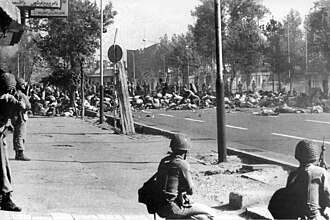
“”The Islamic Republic is not about fun, it is about morality. There is no fun to be had in the Islamic Republic of Iran.
|
| —Khomeini[54] |
Under the Shah's cruel and frivolous reign, something was bound to break. In 1977, mass protests and riots rocked the nation, organized by a strange alliance of secular liberals and hardline Islamists.[55] Matters reached a critical point in mid-1978 when some unknown group burned down a movie theatre with about 420 people inside it.[56] The Shah blamed the protesters, and the protesters were convinced that the Shah's secret police were responsible.[57]
As protests paralyzed Iran, the Shah declared martial law. Despite that, a vast crowd assembled in Tehran's Jaleh Square to celebrate Eid-e-Fitr, the end of Ramadan.[58] Government military police responded with extreme violence, firing on the protesters with live ammunition. Between 400 and 900 people died, and 4,000 were injured.[59] Whatever loyalty the Shah might have had from the Iranian people was shattered instantly. The Shah realized that he fucked up badly, so he ordered his military forces not to interfere with protests. Martial law was no longer enforced, and a general strike shut down the oil industry.[60]
Those strikes destroyed Iran's economy and severed the Shah's last lifeline, as, without oil money, his state had no power at all. The Shah fled to the United States, Khomeini returned from exile, and a series of referendums in 1979 transformed Iran into a theocratic republic under Khomeini's leadership.[61]
Hostage crisis[edit]
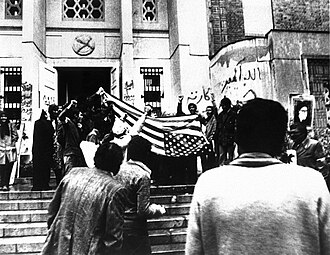
The US really pissed off the new Iranian regime by allowing the Shah to seek protection on American soil. Khomeini demanded that the Shah be returned to face trial, and the US refused, probably and justifiably fearing that the Islamic regime would just execute him. Meanwhile, it became clear that Khomeini's control over his most radical young student followers was tenuous at best. Those student radicals are the ones who organized themselves and launched a rapid takeover of the United States Embassy in Tehran, taking 69 hostages.[62] After the fact, Ayatollah Khomeini voiced his support for the takeover, calling it a "second revolution," and demonstrations in support of the action took place around Iran.[62] Khomeini had initially opposed the violent action but within a day came around to the idea that the embassy takeover was a brilliant tactic to unite the Iranian people and intimidate foreign adversaries.[62]
Initially, the students had intended to occupy the Embassy for only a few days, but this outpouring of national support made it clear that matters had gone out of control. The students released 13 hostages, the women and African-Americans, and they prepared the rest for the long haul.[62] President Jimmy Carter broke off relations with Iran and froze the nation's assets. He also launched a rescue attempt called Operation Eagle Claw that failed miserably due to equipment malfunctions and bad weather; 8 US servicemen died, and Khomeini got to call it divine intervention.[63] This tragic humiliation was probably one of the main causes of Jimmy Carter's election loss.
In 1980, Iran finally came to the negotiating table, as the Shah had died from cancer and Iraq was making war threats. In exchange for some promises by the US not to interfere in Iranian affairs, Iran released the hostages. Iran waited until Carter was just out of the office to let them all go, just as one final "fuck you" to the president they blamed for supporting the Shah.
Iran-Iraq War[edit]
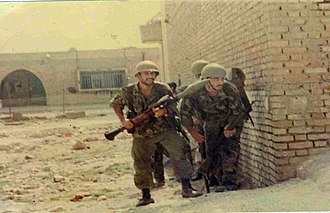
Meanwhile, in Iran's neighbor Iraq, Saddam Hussein had been a longtime enemy of the Shah and was quite happy to see him go. Khomeini, however, knew that Iraq had a significant Shia minority and was eager to turn Iraq into another theocracy allied with Iran. To this end, he encouraged Iraq's Shiite minority to launch a revolt against Saddam's rule, and he frequently instigated violent border clashes between the two nations.[64] Khomeini also called for a Shia revolution in Iraq, which scared the shit out of Hussein's government since Hussein really was treating the Shiites like shit.[65]
Hussein also had ambitions of making himself into a rich regional power. He now hoped to do this by annexing Iran's oil-rich region of Khuzestan directly across the border.[66] Iraq thus launched an all-out invasion of Iran, and they were soon supported by various Sunni Arab states. The United States under Ronald Reagan also pitched in for the team by sending Saddam raw materials to help him construct chemical weapons.[67]
The war ended in 1988 with a costly and bloody stalemate that resulted in no border changes. Iran, though, decisively came out on top. Rather than leading to a collapse of the Khomeini regime like Saddam had hoped, the war actually helped strengthen Iran's fledgling Islamic Republic. Even cultural, ethnic, and religious minorities rallied behind the government to protect it from Hussein's attack.[68] During the war, Iran also reformed its military into a capable fighting force and helped it turn the Revolutionary Guard Corps into the powerful and radical organization it is today.[69] Iranian military deaths are estimated to be around 160,000, and civilian casualties around 16,000.[70]
Iran today[edit]
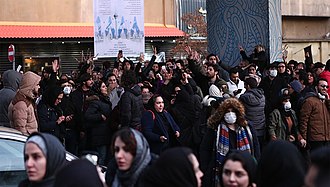
Even with the resurgence of national unity after the war, Khomeini still apparently figured that he needed to do some housecleaning. In 1988, barely after the war finished killing tens of thousands of people, Iran's Supreme Leader issued a fatwa calling for the murder of tens of thousands more. According to secret documents smuggled out of Iran, Khomeini emptied Iran's prisons of political dissidents by simply executing them en-masse. The two-month purge saw 30,000 people executed by hanging from cranes, including children as young as 13.[71][72] Shortly after, Khomeini died of poor health, to be succeeded as Supreme Leader by the equally hardline Ali Khamenei.
After that, Iran sat around for a while, supporting terrorist groups against Israel and undergoing a brief but aborted attempt at liberalization. In 2005, Iran made international headlines again by voting for the deranged extremist Mahmoud Ahmadinejad as president. He immediately started freaking people out by pushing forward with Iran's young nuclear program.[73]
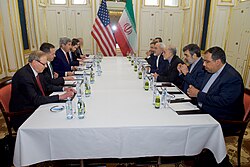
Ahmadinejad also managed to further demolish Iran's image in the eyes of the world with his antisemitism and brinksmanship. In 2006, his government looked on cheerfully while a Holocaust denial-themed national cartoon contest went on in Tehran.[74] Ahmedinejad's repeated rants against Jews drew international condemnation. One of his harshest critics was Fidel Castro, who put the Iranian leader on blast for slandering the Jews while still making it clear that Cuba was still no friend of the US or Israel.[75]
The 2009 Iranian election was heavily disputed, and a mass protest called the Iranian Green Movement called for Ahmadinejad's removal as president.[76]
The current president is Hassan Rouhani, who won the 2013 presidential elections by portraying himself as a moderate.[77] Rouhani agreed to the 2015 nuclear deal with US President Obama to limit Iran's ability to refine weapons-grade nuclear material.[78] Relations between Iran and the United States worsened after the US elected Donald Trump, who unilaterally withdrew from the Iran nuclear deal and assassinated Iranian General Qasem Soleimani.
Iran's economy still suffers from sanctions, and the Iranian people seem tired of the constant stand-offs with other countries. The 2019–2020 Iranian protests started over fuel price rises and rationing due to the sanctions and turned violent when the government murdered about 1,000 people. They were the most severe instance of unrest in Iran since the revolution and, unlike previous protests, spread beyond the urban middle class into rural areas and the poor. Eventually, they were brought under control by state violence and financial assistance to the poor.[79][80][81]
There is also continuing tension with the US and Israel: the US assassinated senior military figure Qassem Soleimani by a drone strike in January 2020, while Israel assassinated Iranian nuclear scientist Mohsen Fakhrizadeh in November. Iraq also shot down a Ukrainian airliner by mistake in January 2020, fearing another American attack, but killing 176 people.[82][83] Joe Biden had suggested more conciliatory policies towards Iran but soon after taking office, launched an airstrike on Iranian-backed militias in Syria.[84]
Changing demographics[edit]
One important factor in the protests of Iran has been the reported decline of Islam amongst the populace, mostly among Iranian youth with veneration for western culture and values and access to the internet. Many of these citizens (especially women) saw the death of Mahsa Amini as the last straw (from historical wrongs done against Iranians, particularly against women and ethnic minorities by Islam, Muslims, and the Islamic regime). In fact, the statistics reported such historic lows that Iran is no longer an Islamic country, being such in name only.[85][86][87]
Because of disinterest in Islamic hegemony, hatred towards Islam due to historical oppression by Muslims against non-Muslims both historically and currently, and the vast majority of Iranians being irreligious anyway, this vacuum has allowed other faiths to spread (Christianity and pagan religions like Zoroastrianism, the ancient religion of Iran and the Iranian peoples), and even lack of faith such as atheism. The Islamic regime has responded to this by sending out Muslim missionaries to convince Iranians to remain in Islam, which they claim through “peaceful means”. This is untrue, due to evidence that the regime has been using violence and clamping down on the opposition to remain in power. In addition, sending out missionaries will only worsen the critical situation of Islam’s decline in Iran. The view of Islam’s steady but fast decline in the country is treated not unlike the slow decline of the white American population in the United States by Trumpists, a supposed decline and fall of civilization that must be stopped or avenged. However, while white Americans are not declining to the point of becoming a minority and systematically erased, Iranian Muslims have declined massively in number compared to other religions (for obvious reasons stated prior).[88][89]
Government[edit]
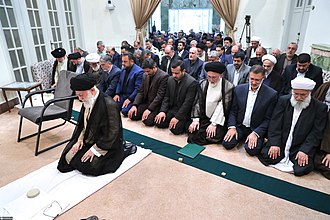
Supreme Leader[edit]
The Supreme Leader of Iran is where the country's true power lies. It was initially filled by Ayatollah Khomeini, the father of the 1979 Iranian Revolution. He appoints the head of Iran's judiciary, most of the Guardian Council, is the commander-in-chief, and hosts Friday prayers on radio and television.[90] He also has to approve the president's election, meaning that he can veto all of the people of Iran. Since he controls the military and most of the government, the Supreme Leader alone can declare war or peace.
According to Iran's Constitution, the Supreme Leader is responsible for delineating and supervising "the general policies of the Islamic Republic of Iran," which means that he sets the tone and direction of Iran's domestic and foreign policies.[91] Also under the Supreme Leader's control are the "foundations", or bonyads. These are state-run corporate alliances that control about 40% of Iran's economy and most of the country's core industries.[91] Should the Supreme Leader die or be dismissed, a "Provisional Leadership Council" is mandated to carry out the responsibilities of the supreme leader. The PLC would then be made up of the incumbent President, the incumbent Chief Justice, and one of the clerics of the Guardian Council, who is selected by the Expediency Discernment Council, an advisory assembly appointed by the Supreme Leader to settle disputes between the Guardian Council and the Majlis.

The Supreme Leader is appointed by the Assembly of Experts, a body of Iran's highest religious authorities who make sure to appoint a religious fanatic like them to the country's highest office.[93] Only Shia Islamic clergy can be members of the Assembly, and they are officially endowed with the right to dismiss the Supreme Leader, but they predictably never have. All candidates for the Assembly must have their candidacy approved by the Guardian Council, where 50% of its members are appointed unilaterally by the Supreme Leader, and the other half is subject to confirmation by the Majlis after being appointed by the head of the Iranian judiciary, who is himself appointed by the Supreme Leader.
The current Supreme Leader is Ali Khamenei, president from 1981 through 1989. He has ruled the country for over three decades, most of the Islamic Republic's existence, but talk of his ailing health, impending death, and potential successors is verboten and straight-up illegal; many have gotten arrested for discussing such things even in private.[94] There have only been two Supreme Leaders: Khomeini, who founded the Islamic Republic, and Khamenei, who has led the country since.
There used to be a Deputy Supreme Leader under Khomeini, Ayatollah Hussein-Ali Montazeri, Khomeini's designated successor. However, the two had a falling out in 1989 due to Montazeri criticizing Khomeini's policies which Montazeri felt infringed on people's rights and freedoms.[95] Ayatollah Montazeri was placed under house arrest by Khamenei for criticizing Khamenei's policies. Still, he was allowed to speak his mind when it came to his disagreements with the regime, thereby serving as a focal critic and unofficial leader of the opposition to the Islamic Republic till his death of old age.[96] While he was a firm believer in an Islamic state, Ayatollah Montazeri argued in favor of Baháʼí rights, civil rights, women's rights, and democratic rights and freedoms. He felt Iran was not an Islamic state because it was not respecting people's rights. One wonders how Iran would have been had Ayatollah Montazeri taken over instead of Khamenei. Predictably, Khamenei has not elevated anyone to be his deputy, which is why talk of his succession is so unpredictable.
President[edit]
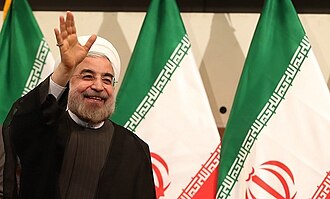
The president is the second-highest-ranking official in Iran. He's high profile internationally, but he doesn't do a lot since the constitution limits his powers and officially subordinates him to the Supreme Leader.[91] The president does not have the power to veto and cannot dismiss or reinstate cabinet ministers; only the Supreme Leader can. The president does not have the authority to make foreign policy decisions by himself, although the Supreme Leader often lets him.[97] The president is directly elected, but he can be dismissed for any reason by the Supreme Leader. Surprisingly, this had not happened yet, even when Iranians chose reformist presidents. This exemplifies Iran's bizarre political system and culture.
While the President is merely the head of government for Iran, they are still the highest popularly elected official. The cabinet does follow the president's lead as you would expect a functioning procedural democracy to operate. The president is generally the forger of foreign policy instead of the supreme leader, which is why multiple presidents were moderates or reformists who tried to engage with the West. But it wasn't until the destruction of the reform movement in the mid-2000s that the presidency truly became a power in itself. Beyond political appointments, the constitution also grants the president responsibility for "national planning, and budget and state employment affairs." From 1981 through 2017, every incumbent president had been reelected: Ali Khamenei (1981-1989), Akbar Hashemi Rafsanjani (1989-1997), Mohammad Khatami (1997-2005), Mahmoud Ahmadinejad (2005-2013), and Hassan Rouhani (2013-2021). This streak ended in 2024 when Ebrahim Raisi was killed in an accidental helicopter crash; he was replaced by Masoud Pezeshkian, another moderate in a similar mold as Rouhani.
Prime Minister (1906–1989)[edit]
For a time, Iran used to have both a president and a prime minister because the prime minister was a holdover office from the Shah's years which briefly survived into the Islamic Republic. Mehdi Bazargan, the 46th prime minister of Iran, was the first prime minister of the Islamic Republic as he was appointed right after the Islamic Revolution. This meant Iran had two heads of government with a left-leaning parliament, forcing Khomeini to compromise with liberals and democracy supporters. This was meant to divide the executive and prevent a counter-coup against the revolution. But the prime minister only lasted ten years into the Islamic Republic. Bazargan, who hoped for liberal democracy and accommodation with the West, resigned during the hostage crisis as a protest against the hostage-taking and acknowledging of his government's failure to release the American diplomats.[98] Bazargan would remain in parliament as a prominent critic of the regime, penning a letter to the Speaker of the Majlis saying the Islamic Republic "has created an atmosphere of terror, fear, revenge and national disintegration."[99]
Iran's most famous prime minister was Mohammad Mossadegh, during the reign of the Pahlavi dynasty, all the way back in the 1950s, almost thirty years before the Islamic Republic. At this time, the British owned the Anglo-Iranian Oil Company, so all the money from oil production went to wealthy white men half a planet away, even though it was Iranian oil from Iranian workers. Elected on a promise to nationalize oil, Mossadegh did exactly that and was overthrown in a coup by the British under Winston Churchill and the Americans under Dwight Eisenhower, with the CIA spearheading the push. His overthrow forever changed the course of Iran, as the Shah was installed as an absolute monarch who would later be overthrown by the Ayatollah, leading to modern-day Iran.
Guardian Council[edit]
These guys are why Iran's reformists can't get any lasting change for the country. The Guardian Council has twelve members, and six are appointed by the Supreme Leader.[91] The Guardian Council puts the "Islamic" into the "Islamic Republic." It interprets the constitution to determine if parliament's laws align with sharia law.[91] It also does background checks on presidential and parliamentary candidates to make sure that they are loyal Shia Muslims who will uphold shariah. Sorry, Iranian voters, but you don't really get a choice in your elections.
Islamic Consultative Assembly[edit]
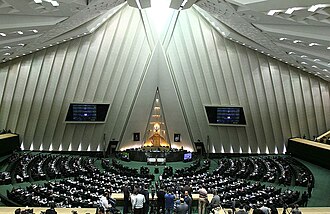
Iran's parliament, officially called the "Islamic Consultative Assembly", is a unicameral body of 290 representatives who serve four-year terms.[100] The parliament can pass laws, but those laws have to be vetted by the Guardian Council and the Supreme Leader. The parliament's lack of power was demonstrated quite effectively in 2000 when liberal reformists won a majority. Their attempts at liberalization were nullified by the Council, and the reformists were later barred from running for reelection.[101]
The parliament is also currently barred by the Supreme Leader from having any say in foreign policy or Iran's nuclear policy.[102]
Revolutionary Guard Corps[edit]
The Revolutionary Guard Corps is distinct from the rest of the Iranian military. Despite having less manpower than the military, the IRGC is responsible for patrolling Iran's waters, overseeing its missiles, and supporting terrorist groups abroad.[103] The force answers only to the Supreme Leader. The infamous and secretive Quds Force is part of the IRGC, and it currently has relations with armed militant groups in places like Afghanistan, Iraq, Lebanon, Syria, and Palestine. The Quds Force was blamed for both the 1983 bombing of the US Embassy in Beirut and the attack on barracks housing American and French service members, which claimed the lives of 307 people.[104] The Quds Force was one of the most effective armed groups resisting DAESH expansion. Its leader Qasem Soleimani was assassinated by the United States at the order of Donald Trump.
Foreign relations[edit]

United States[edit]
The US and Iran haven't had official diplomatic relations since 1980, which isn't surprising since Iran violated diplomatic immunity with that whole embassy fiasco. At first, the 1979 Revolution really wasn't an anti-American revolution, since it targeted the Shah. However, the Iranian people couldn't help but notice that the Shah was a close friend/puppet of the US.[105] The Jimmy Carter administration also made some foolish diplomatic missteps during this time. Carter invited the Shah to the US to express American support for him, and he rarely criticized the Shah's bad habit of having people murdered and tortured.[105] Finally, Carter invited the Shah to the US for cancer treatment and to avoid arrest by the new Iranian authorities. None of that sat well with the Iranians.
After the severing of relations, the US has adopted a strategy of containment towards Iran by diplomatically aligning with Iran's adversarial neighbors and stationing US troops and bases on their soil.[2] Hence the infamous map of the poor innocent Iranian state surrounded by US bases. The US also shot down an Iranian civilian aircraft in 1988, and George W. Bush referred to Iran as part of the new "Axis of Evil" in 2002.[106]
The US has maintained economic and military sanctions against Iran since the revolution.[107] Sanctions were lifted briefly after the nuclear deal but were reimposed by the Trump administration. Trump's strategy was one of "maximum pressure", hoping that the Iranians would capitulate. Unfortunately, the Iranians will never do that because they would rather face any consequence than return to the days of Western control and domination of their country.[105]
Israel[edit]
Iran officially doesn't recognize Israel as a legitimate state, and Israel has turned into one of Iran's archnemeses on the global stage. Iran supplies weapons and goods to Hamas, a terrorist group in the Gaza Strip.[108] Iran also supports Hezbollah in the same manner in Lebanon along Israel's northern border. Iran currently recognizes Jerusalem as Palestine's capital, in direct opposition to the US recognition of the city as Israel's capital.[109]

For its part, Israel has adopted a strategy of deterrence that has manifested as extreme aggression. Israel has taken inflammatory measures like striking Iranian targets with rockets and threatening to attack Iran if it develops a nuclear device.[110][111]
Saudi Arabia[edit]
Even more so than Israel, Saudi Arabia is Iran's archnemesis in the Middle East. Much of the conflict is religious, as a Sunni theocracy and a Shia theocracy were never destined to get along very well.[112] Iran hates that Saudi Arabia has aligned with the US and allows American soldiers to protect Islam's holy land.
In recent times, their "cold war" has heated up considerably. In many ways, Iran seems to be winning. The Yemeni Civil War still rages along Saudi Arabia's southern border, with the Shia Houthi rebels possibly receiving aid from Iran.[112] Iran also has its proxy Hezbollah in charge of much of Lebanon, and its Shia militias used the war against DAESH to take over large swathes of Iraq.[113] The Saudis have also mobilized their allies like Egypt, Jordan, and Bahrain to push back against Iranian power. Israel has also formed an unlikely common cause with Saudi Arabia, as Israel considers Iran a much more imminent threat.
Human rights[edit]
.jpg)
Executions[edit]
Iran executes hundreds of people per year. Those high numbers are mainly due to Iran's horrifyingly harsh drug laws; before 2017, drug abuses came with mandatory death sentences.[114] Although that law was amended, people are still executed for drug offenses, although in lesser numbers.
People may also be executed for crimes they allegedly committed as children, and judges have wide discretion to impose death in these cases. Iranian law considers acts such as "insulting the prophet," "apostasy," same-sex relations, and adultery as crimes punishable by death.[114] More than 100 offenses, including drinking alcoholic beverages and extramarital sex, can be punished with flogging.
Iran is also one of the only countries to practice public executions, apparently with the idea that the display will deter other criminals.[115] It doesn't seem to be working since so many people are executed per year.
Freedom of expression, association, and assembly[edit]
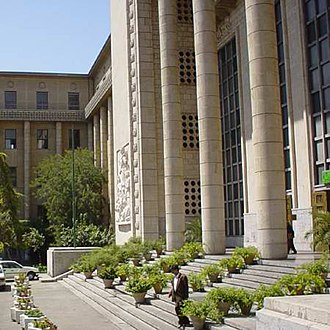
Iran does not respect the human right to freedom of expression or assembly. Most recently, Iran shocked and horrified the world by killing, arbitrarily arresting, and torturing thousands of people who participated in the 2019-2020 protests.[116] That harsh crackdown was followed by days of mass arrests to terrify people into silence.
The regime also regularly sends people to prison for unreasonably long sentences for minor crimes. Many victims of this tactic are:
- Human rights activists.
- Labor rights activists.
- Environmental activists.
- Minority rights activists.
- Women’s rights activists.
- Anti-death penalty campaigners.
- People who ask the government to be truthful about the 1988 mass murders conducted by Khomeini.[117]
Independent civil society and human rights groups are banned. All forms of media are censored, and foreign broadcasts are blocked.
Due process and mistreatment of prisoners[edit]
Iranian law enforcement regularly extracts confessions from prisoners by using torture, which is a notoriously unreliable method for getting an accurate view of the truth.[114] Iran also denies prisoners access to legal counsel and denies medical care to prisoners even in cases of severe preexisting conditions.[114]
Many people have died in prison due to torture. Prisons are inhumane, featuring conditions like overcrowding, prolonged solitary confinement, denial of medical care, denial of food and water, and insect infestations.[117] In other cases, prisoners are punished with disfigurement. The Islamic Penal Code makes many crimes punishable by torture methods, including flogging, blinding, and forced amputation. In July, Kurdish singer Peyman Mirzazadeh was subjected to 100 lashes after being convicted on "drinking alcohol" charges.[117] In October, a prisoner’s hand was amputated for theft in a prison in Sari, Mazandaran province.[117]
Women's rights[edit]

As you might expect, women face severe discrimination. Women may not obtain a passport or travel outside the country without written permission from the primary man in their life. Wearing the hijab is compulsory. In August 2019, Iranian civil rights activist Saba Kord Afshari was sentenced to 24 years in prison, including a 15-year term for taking off her hijab in public, which Iranian authorities say promoted "corruption and prostitution".[118]
Women may be stoned to death for adultery, while men rarely get so severe a punishment for the same crime.[119] Indeed, Iranian law recognizes a man's right to marry more than one woman at a time. Women, of course, do not get the same right. Men have the unilateral right to divorce women, a right women do not have.
However, in stark contrast to Saudi Arabia's harsh laws maintained until recently, Iranian women have the equal right to drive, vote, do not need to be accompanied by a male member of their families in public places, and have surpassed men in university entrance exams unlike any other country in the region.[119]
Discrimination against religious minorities[edit]
The Baháʼí Faith is a religion that originated in Iran between the years 1844 and 1863; it is not (as it is commonly misperceived to be) a branch or sect of Islam, but a new and independent religion that arose in a Twelver Shia Muslim context, the same way Christianity arose in a Jewish context and Buddhism arose in a Hindu context. Bahá’í law forbids cisgender gay and lesbian Bahá’ís to get married and requires transgender Bahá’ís to enter into “straight” marriages, and it also excommunicates people who break its unique “Covenant”, but aside from that, it is about as peaceful and universally loving a religion as could be imagined. Its prophet, Bahá’u’lláh (who is believed by the Bahá’í community to be the return of Jesus Christ “in the glory of the Father”), and his son, ‘Abdu’l-Bahá, taught that all human beings are worthwhile and that all religions should be respected.[120] The Bahá’ís also refrain from partisan political involvement and civil disobedience. In other words, they’re about as threatening as a chihuahua puppy. But because they believe that Muhammad was not the last prophet in all of religious history ever (believing as they do that Bahá’u’lláh came after him and that more will come after Bahá’u’lláh’s era ends sometime around the year 3000), the Iranians treat them as dangerous criminals. Members of the Baháʼí community in Iran have been subjected to unwarranted arrests, false imprisonment, beatings, torture, unjustified executions, confiscation and destruction of property owned by individuals and the Baháʼí community, denial of employment, denial of government benefits, denial of civil rights and liberties, and denial of access to higher education.[121]
Although other religions are free to practice, they still face restrictions. Non-Shia Muslims are still expected to live according to Iran's harsh religious laws. Only Shia Muslims may hold government positions or take certain jobs. A Zoroastrian named Sepanta Niknam faced harsh opposition when he ran for city council in the central city of Yazd in 2017, and Zoroastrians, who love and revere dogs, also often fall afoul of Iran’s harsh sharia rulings against them. Converts to Christianity from Islam are routinely tortured and imprisoned; only those born Christian can practice freely. There is a Hindu mandir in Iran, but the Hindu community is not legally recognized and has faced discrimination concerning the question of unequal sums of blood money paid in cases of murders of Hindus by Twelver Shia Muslim citizens. A practitioner of Eckankar and his wife, a non-Eckist translator of Eckist books into Farsi, were sentenced to death in 2017. Atheists risk arbitrary detention, torture, and the death penalty for "apostasy".[117] Iranian Jews generally live safely as long as they publicly support the Palestinian national cause and do not even gesture in the direction of supporting Zionism.
Discrimination against ethnic minorities[edit]
Ethnic minorities, including Ahwazi Arabs, Turks, Azerbaijanis, Azeris, Baluchis, Kurds, Turkmens, Yazidis, Afro-Iranians, Iranian Jews, and Indian Iranians face institutional discrimination. Challenges for them include lack of access to education and employment and perpetual government neglect of their communities, impacting their ability to access essential services.[117] Ethnic rights activists are sentenced to unreasonably long prison sentences. As they are largely Sunni, Kurds and Baluchis have been especially discriminated against by the government, and they faced much of the government violence in response to the Mahsa Amini protests.[122]
Iran's mistreatment of the Baluchi people has resulted in a low-intensity insurgency waged by Baluchi nationalists along Iran's border with Pakistan.[123]
Gallery[edit]
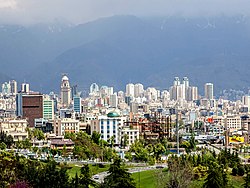
Tehran, Iran's capital.
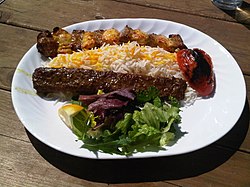
Chelow kabab, one of Iran's national dishes.
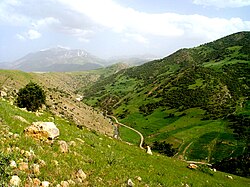
Iran's mountainous landscape.
.jpg)
Prayers at the Imam Reza shrine.
.jpg)
Iranians at an electronics expo in Tehran.
_Mosque,_Isfahan,_Iran_(14474999965).jpg)
Shah Mosque in Isfahan.
See also[edit]
- India
- Hinduism
- Zoroastrianism
- Iran-Contra
- Hojatoleslam Kazem Sedighi
External links[edit]
- Cheeky BBC quiz on your eligibility to be the Iranian president.
References[edit]
- ↑ Toast by the President at a Luncheon Given in His Honor by Shah Mohammad Reza Pahlavi. December 14th, 1959.
- ↑ 2.0 2.1 Map: US bases encircle Iran. Al Jazeera.
- ↑ Persia, Iran, and the Persian Gulf: A Brief History of Names. "The suggestion for the name change from Persia to Iran is said to have come from the Persian ambassador to Germany, who was a Nazi sympathizer."
- ↑ 4.0 4.1 Self-Orientalization and Dislocation: The Uses and Abuses of the "Aryan" Discourse in Iran by Reza Zia-Ebrahimi (2011) Iranian Studies 44(4):445-473. doi:10.1080/00210862.2011.569326.
- ↑ Persia or Iran, Persian or Farsi by Ehsan Yarshater (1989) Iranian Studies 22(1) (archived from June 15, 2019).
- ↑ Iranian or Persian – the debate continues. KIRN 670 AM Persian News, Talk and Info. 12 April 2021.
- ↑ Early humans in Iran were growing wheat 12,000 years ago. NBC News.
- ↑ A Remarkable Discovery... University of Pennsylvania.
- ↑ Iran’s legendary ruined city “Susa”, Arkeonews, August 12, 2021
- ↑ Trends in Lingustics, Brian D. Joseph, 2009 (pg. 69)
- ↑ Tchogha Zanbil. UNESCO.
- ↑ Ancient Iran. Country Studies.
- ↑ 13.0 13.1 Immigration of the Medes and the Persians. Country Studies.
- ↑ 14.0 14.1 14.2 Achaemenid Empire. Ancient History Encyclopedia.
- ↑ Zarathustra. Ancient History Encyclopedia.
- ↑ Darius I. Ancient History Encyclopedia.
- ↑ 17.0 17.1 The Achaemenid Empire. Country Studies.
- ↑ See the Wikipedia article on Battle of Issus.
- ↑ 19.0 19.1 Alexander the Great. Country Studies.
- ↑ Seleucid Empire. Ancient History Encyclopedia.
- ↑ 21.0 21.1 Parthia (Empire). Ancient History Encyclopedia.
- ↑ 22.0 22.1 The Sassanids. Country Studies.
- ↑ Paul Kane (2009). "Emerson and Hafiz: The Figure of the Religious Poet". Religion & Literature. 41 (1): 111–139. JSTOR 25676860.
- ↑ Iran in History. Tel Aviv University. Archived.
- ↑ 25.0 25.1 25.2 25.3 25.4 Iran: Islamic Conquest. Country Studies.
- ↑ See the Wikipedia article on Seljuk Empire.
- ↑ See the Wikipedia article on Order of Assassins.
- ↑ Steven R. Ward (2009). Immortal: A Military History of Iran and Its Armed Forces. Georgetown University Press. p. 39. ISBN 978-1-58901-587-6.
- ↑ Mongols and Tamerlane. Country Studies.
- ↑ 30.0 30.1 30.2 30.3 The Safavids. Country Studies.
- ↑ Akiner, Shirin (5 July 2004). The Caspian: Politics, Energy and Security. Taylor & Francis. ISBN 9780203641675.
- ↑ 32.0 32.1 See the Wikipedia article on Safavid conversion of Iran to Shia Islam.
- ↑ See the Wikipedia article on Afsharid dynasty.
- ↑ Steven R. Ward (2009). Immortal: A Military History of Iran and Its Armed Forces. Georgetown University Press. p. 39. ISBN 978-1-58901-587-6.
- ↑ 35.0 35.1 35.2 The Qajars. Country Studies.
- ↑ See the Wikipedia article on Persian Constitutional Revolution.
- ↑ The Constitutional Revolution. Country Studies.
- ↑ Malekzadeh, Mehdi. History of Persian Constitutional Revolution. Sokhan publication. p. 1241. ISBN 964-372-094-2.
- ↑ Iran: World War I. Country Studies.
- ↑ See the Wikipedia article on 1921 Persian coup d'état.
- ↑ 41.0 41.1 41.2 Era of Reza Shah. Country Studies.
- ↑ See the Wikipedia article on Anglo-Persian Oil Company.
- ↑ See the Wikipedia article on Anglo-Soviet invasion of Iran.
- ↑ What if the Islamic Revolution Never Happened?
- ↑ 45.0 45.1 45.2 Mossadegh and Oil Nationalization. Country Studies.
- ↑ How The CIA Overthrew Iran's Democracy In 4 Days. NPR.
- ↑ See the Wikipedia article on 1953 Iranian coup d'état.
- ↑ The Shah's White Revolution. Country Studies.
- ↑ White Revolution (1961–1963). Encyclopedia.com
- ↑ Mohammad Reza Pahlavi, the last king of Iran. France24.
- ↑ 51.0 51.1 Shah of Iran modernized his nation but vacillated in crisis. Associated Press.
- ↑ Iran. Amnesty International 1976.
- ↑ Elizabeth Shakman Hurd (2009). The Politics of Secularism in International Relations. Princeton University Press. p. 75. ISBN 978-1-4008-2801-2.
- ↑ When Iran’s ‘morality police’ came for me by Pardis Mahdavi (September 26, 2022 at 2:19 p.m. EDT) The Washington Post.
- ↑ Abrahamian, Ervand (1982). Iran between two revolutions. Princeton University Press. ISBN 0-691-00790-X. p. 515
- ↑ See the Wikipedia article on Cinema Rex fire.
- ↑ Daniel, Elton L. and Mahdi, Ali Akbar (2006) Culture and Customs of Iran, Greenwood Press, Westport, Connecticut, page 106, ISBN 0-313-32053-5
- ↑ See the Wikipedia article on Black Friday (1978).
- ↑ Iran: One Revolution at a Time. Huffington Post.
- ↑ Letter from Iran. The New Yorker. Archived.
- ↑ Lori A. Johnson; Kathleen Uradnik; Sara Beth Hower (2011). Battleground: Government and Politics [2 volumes]: Government and Politics. ABC-CLIO. p. 319. ISBN 978-0-313-34314-8.
- ↑ 62.0 62.1 62.2 62.3 The Hostage Crisis, 30 Years On. PBS.
- ↑ See the Wikipedia article on Operation Eagle Claw.
- ↑ Mearsheimer, John J.; Walt, Stephen M. (12 November 2002). Can Saddam Be Contained? History Says Yes. International Security. Belfer Center for Science and International Affairs.
- ↑ Karsh, Efraim (25 April 2002). The Iran–Iraq War: 1980–1988. Osprey Publishing. pp. 1–8, 12–16, 19–82. ISBN 978-1-84176-371-2.
- ↑ Farrokh, Kaveh. Iran at War: 1500–1988. Oxford: Osprey Publishing. ISBN 978-1-78096-221-4.
- ↑ Exclusive: CIA Files Prove America Helped Saddam as He Gassed Iran SHANE HARRIS AND MATTHEW M. AID | AUGUST 26, 2013
- ↑ Lessons from the Iran-Iraq War: Iranian Minorities Won’t Lead Transformative Change Bolurchi, Neda. Atlantic Council. Aug 17, 2018
- ↑ How Powerful Is Iran’s Revolutionary Guard Corps? Council on Foreign Relations. Ray Takeyh. June 16, 2016
- ↑ Hiro, Dilip (1991). The Longest War: The Iran-Iraq Military Conflict. New York: Routledge. p. 205. ISBN 978-0-415-90406-3. OCLC 22347651.
- ↑ Khomeini fatwa 'led to killing of 30,000 in Iran'. The Telegraph.
- ↑ The UN should investigate the 1988 massacre in Iran. The Hill.
- ↑ Iran hardliner becomes president. BBC News.
- ↑ See the Wikipedia article on International Holocaust Cartoon Competition.
- ↑ Fidel Castro accuses Mahmoud Ahmadinejad of antisemitism. The Guardian.
- ↑ See the Wikipedia article on Iranian Green Movement.
- ↑ Iran election: It's close as moderate Hassan Rouhani fights for second term. USA Today.
- ↑ Iran nuclear deal: Key details. BBC News.
- ↑ See the Wikipedia article on 2019–2020 Iranian protests.
- ↑ Iran’s protests: All you need to know in 600 words, Al-Jazeera, 20 Nov 2019
- ↑ Iran November 2019 Protests, Danish Ministry of Immigration and Integration/Danish Immigration Service, July 2020
- ↑ See the Wikipedia article on Ukraine International Airlines Flight 752.
- ↑ Iran: Events of 2020, Human Rights Watch
- ↑ US carries out air strikes in Syria targeting Iranian backed militias, CNN, Feb 25, 2012
- ↑ https://www.thebulwark.com/the-islamic-republic-is-killing-islam-in-iran/
- ↑ https://www.iranintl.com/en/202303116431
- ↑ https://www.mnnonline.org/news/i-think-were-seeing-the-collapse-of-islam/
- ↑ https://nymag.com/intelligencer/article/iran-secular-shift-gamaan.html
- ↑ https://theconversation.com/irans-secular-shift-new-survey-reveals-huge-changes-in-religious-beliefs-145253
- ↑ Supreme Leader. BBC News.
- ↑ 91.0 91.1 91.2 91.3 91.4 Structure of Power in Iran. PBS.
- ↑ 2. 83-year-old @khamenei_ir has been ruling since 1989. He's the only leader many young protestors have ever known. The institutions he's empowered-and empower him-are likeminded hardliners whose main source of diversity is whether their beards and turbans are black or white by Karim Sadjapour (10:32 AM · Sep 24, 2022) Twitter (archived from 30 Sep 2022 15:42:38 UTC).
- ↑ Assembly of Experts. BBC News.
- ↑ Does Iran have a plan for a successor to Khamenei? by Ali Hashem (December 24, 2020) Al-Monitor.
- ↑ See the Wikipedia article on [[wp:Hussein-Ali Montazeri |Hussein-Ali Montazeri]].
- ↑ Hossein Ali Montazeri. Britannica.
- ↑ President. BBC News.
- ↑ Bazargan resignation increases Iran risks to American Hostages by Geoffrey Godsell (Nov. 9, 1979) The Deseret News via The Christian Science Monitor.
- ↑ "Khomeni's grip appears at its tightest," The New York Times. 21 November 1982.
- ↑ See the Wikipedia article on Islamic Consultative Assembly.
- ↑ Parliament. BBC News.
- ↑ Iran announces low poll turnout, blames coronavirus 'propaganda'. Reuters.
- ↑ Profile: Iran's Revolutionary Guards. BBC News.
- ↑ What is Iran's secretive Quds Force? NBC News.
- ↑ 105.0 105.1 105.2 A history of U.S.-Iran relations. Penn Today.
- ↑ US-Iran relations: A brief history. BBC News.
- ↑ See the Wikipedia article on United States sanctions against Iran.
- ↑ Cyprus: Ship violated UN resolutions. Jerusalem Post.
- ↑ Iran says Jerusalem 'unchangeable' capital of Palestine. Al Jazeera.
- ↑ Your questions answered on Iran and Israel relations. BBC News.
- ↑ Israel threatens strikes on Iranian nuclear targets. The Scotsman.
- ↑ 112.0 112.1 Why Saudi Arabia and Iran are bitter rivals. BBC News.
- ↑ The Iran Cables: Secret Documents Show How Tehran Wields Power in Iraq. New York Times.
- ↑ 114.0 114.1 114.2 114.3 Iran World Report 2020. Human Rights Watch.
- ↑ See the Wikipedia article on Public executions in Iran.
- ↑ Iran: Thousands arbitrarily detained and at risk of torture in chilling post-protest crackdown. Amnesty International.
- ↑ 117.0 117.1 117.2 117.3 117.4 117.5 Iran 2019. Amnesty International.
- ↑ Iranian civil rights activist gets prison for taking off hijab in public. New York Post.
- ↑ 119.0 119.1 Gender Inequality and Discrimination: The Case of Iranian Women. Iran Human Rights Documentation Center.
- ↑ See the Wikipedia article on Baháʼí Faith.
- ↑ See the Wikipedia article on Persecution of Baháʼís.
- ↑ “Kurds and Baluch are brothers, thirsty for the leader’s blood” – Iran’s minorities, the Mahsa Amini Protests and Iranian identity The Oxford Middle East Review, December 20 2022.
- ↑ See the Wikipedia article on Insurgency in Balochistan.
Categories: [Anti-Christian bigotry] [Anti-Western] [Antisemitism] [Atheophobia] [Asian countries] [Authoritarian regimes] [Fundamentalism] [Government incompetence] [Homophobia] [Iran] [Islam] [Islamism] [Islamic extremism] [Racism] [Middle Eastern countries] [Religious discrimination] [Sexism] [Terrorism] [Theocracy] [Totalitarianism] [Transphobia] [Zoroastrianism]
↧ Download as ZWI file | Last modified: 08/13/2025 04:44:40 | 151 views
☰ Source: https://rationalwiki.org/wiki/Iran | License: CC BY-SA 3.0

 KSF
KSF